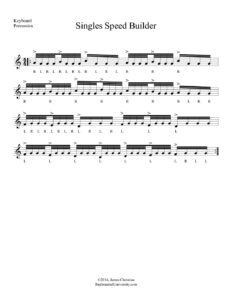Here is the next installment of videos from my book The Art of Multi-Tenor Drumming. In addition to thousands of exercises, the book contains 33 etudes. This is etude #27 entitled “Maze.”
Here are the performance notes from the book:
This etude is dedicated to DCI snare champion, Ken Mazur. His books have done a lot to help me grow in my playing, and they were a great inspiration to me in writing this book. The etudes in this section were largely inspired by the “Rudimental Performance” etudes in his orange book [The Basic Technique of Rudimental Drumming]. In fact, this etude can be played as a duet with the final “Rudimental Performance” etude, or it can be played as a stand-alone solo. If played as a duet, the first two measures are a solo introduction, and the snare part would come in on measure 3. I have always loved the snare etude, and I thought it would be nice to have a tenor version of it. (With the added arounds and sweep patterns, the tenor part is slightly more difficult, but you have to be a pretty good player to play either version well.)
In adapting this etude to tenors, I looked to the Marty Hurley/Lee Hansen snare/tenor duets, such as Phantom of the Phield and Phantom Phrenzy. Of course, Ken Mazur was a student of Marty Hurley, and you can hear Hurley’s influence in Mazur’s writing. The Hurley solos were originally written as stand-alone solos. Later, Lee Hansen (another student of Hurley’s) wrote tenor accompaniments that could be played as either a stand-alone tenor solo or a duet with the snare part. These solos were all written for quads (four drums), and I decided to do the same here.
As you play through this etude, you will find that the structure has a really good sense of momentum, and a lot of different rudiments are incorporated. It’s a lot of fun to play, and there are several rudimental surprises throughout. Whether you play it as an individual solo or as a duet with a good snare drummer, it should thoroughly engage any audience.
I hope you enjoy the video!

